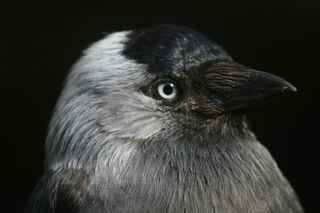Birds Read Human Eyes

Edgar Allan Poe's raven may possess demonic "fiery eyes," but its smaller jackdaw relative can interpret human eye cues and even follow human gestures such as pointing.
The jackdaw's ability to read communicative cues puts it on par with rhesus monkeys and chimpanzees, according to new research.
"I think they can generalize to human eyes somehow, and interpret human eyes as eyes," said Auguste Bayern, a cognitive biologist at the University of Oxford and lead author on a study in the April 2 online issue of the journal Current Biology.
Jackdaws possess human-like eyes with dark pupils and light blue or silvery irises. And that may give the social birds an edge in understanding signals from friendly humans.
Hand-raised birds in the study could find food in a "cooperative" scenario when a familiar person's eyes looked back and forth from the food to the bird. They also responded when the person pointed to the food's location, but did not react when the person turned their head toward the food.
Wary response
That sensitivity to human eye signals contrasts with the lesser sensitivity of birds such as chickens, Bayern told LiveScience. She explained that many birds are sensitive to eye-like patterns without showing much understanding of more subtle eye cues that communicate information.
Sign up for the Live Science daily newsletter now
Get the world’s most fascinating discoveries delivered straight to your inbox.
However, the jackdaws took longer to approach food when an unfamiliar person was watching, and in this case paid attention to where a person's head was turned. A similar delayed reaction occurred when the person kept an eye closed or was glancing away with one eye on the food, even when the researchers replaced the person with images of a person's face.
The skittish response to unfamiliar humans may reflect an evolved response to potential predators or other threats, when subtle eye cues are less important than head orientation, Bayern said. Predator birds such as owls and goshawks tend to turn their entire head when looking — and besides, it's probably too late for any unlucky jackdaws close enough to see a predator's subtler eye movements.
Jackdaws may have evolved a response to more subtle eye cues not from threat of predation, according to the study, but instead from cooperation as social animals. The birds often form lifelong partnerships with mates, and their survival success depends on close communication.
Big brains
This fits with the theory that social sophistication may select for intelligence in evolution, Bayern said. Jackdaws belong to the corvid family of birds, which biologists consider among the most intelligent birds along with parrots. Some crow cousins have demonstrated tool-usage on par with that of apes.
"If you compare them to apes, our closest relatives, they've got exactly the same brain size relative to body size and weight," Bayern noted.
Even chimpanzees have shown themselves less responsive to eye cues, possibly because their darker eyes lack the contrast between white human eyeballs and darker pupils.
"As it looks now, apes are surprisingly bad at looking at eyes, because it seems like other cues such as head direction are much more important," Bayern said. "But I think they understand a bit."
- Video - Making Tools Out of Twigs
- Vote - Birds of Prey: Spot Today's Dinosaurs
- Tool Time: Crows Share Tricks of the Trade
Most Popular


